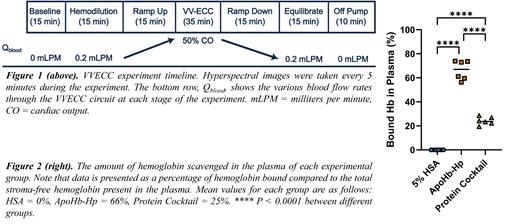Introduction
Extracorporeal circulation (ECC) procedures circulate blood outside the body, either to apply a process or to take over an organ's function. The circuits used for these procedures often utilize a pump to drive blood flow. These pumps subject red blood cells to excessively high shear stresses, leading to hemolysis and release of hemoglobin (Hb) into the plasma. Acellular free hemoglobin is detrimental, increasing nitric oxide (NO) scavenging and leading to hypertension and vasoconstriction, as well as increasing oxidative stress, endothelial dysfunction, and tissue damage. The goal of the present study was to determine whether natural and synthetic protein solutions that sequester heme and Hb can reduce the inflammation and organ damage in a small rodent model of venovenous ECC (VVECC). The present study investigates two different scavenging solutions: i) a solution containing native proteins such as haptoglobin, hemopexin, and transferrin (Protein Cocktail) and ii) a solution containing the apohemoglobin-haptoglobin (ApoHb-Hp) complex, which is a synthetic heme and Hb scavenger.
Methods
Male Golden Syrian hamsters were instrumented with a dorsal window chamber prior to the day of the experiment. On the day of the experiment, animals were anesthetized using inhaled isoflurane and prepped for cannulation surgery. A drainage cannula was inserted into the right jugular vein, advanced past the heart, and positioned in the inferior vena cava. A reinfusion cannula was inserted into the left jugular vein and advanced into the left cranial vena cava to return blood to the right atrium. An arterial catheter was inserted into the left carotid artery for arterial blood access. After surgery, the animal was transferred to the VVECC setup, where the cannulas were spliced into the ECC circuit. The circuit consisted of a peristaltic pump and bubble trap and was primed with one of three solutions: i) 5% human serum albumin (HSA, control), ii) ApoHb-Hp, or iii) Protein Cocktail. The animal was situated on a motorized stage below a hyperspectral camera, which took images of the microvasculature contained in the window chamber every 5 minutes to assess Hb oxygen saturation (HbsO2) within individual arterioles and venules. VVECC was broken up into 7 different stages based on blood flow through the circuit, as shown in Figure 1. After 2 hrs of VVECC, the animal was euthanized, and tissue samples were taken for biomarker analysis. In half the animals, the right kidney was excised for histology and stained for iron. Plasma samples taken after draining the circuit were analyzed using size exclusion chromatography (SEC) to quantify the amount of free or bound Hb.
Results
The two scavenging solutions showed significant increase in the percentage of bound Hb compared to the HSA control ( Figure 2). The ApoHb-Hp scavenged significantly more Hb than the Protein Cocktail. Urinary creatinine, u-NGAL, BUN, KIM-1 (markers of renal damage) all showed a significant reduction in ApoHb-Hp compared to the HSA control. Additionally, staining of kidney sections revealed a reduction in iron deposits in the ApoHb-Hp group compared to the HSA control. Next, we evaluated AST and ALT, which are markers of liver function, to identify any differences in hepatic damage. We found that AST levels significantly decreased in both scavenging solutions compared to the HSA control. On the other hand, ALT showed a significant decrease only in the ApoHb-Hp group when compared to the HSA control.
Conclusion
This study aimed to evaluate the effectiveness of two different heme and Hb scavenging solutions when used to prime an ECC circuit. The primary focus was on their ability to reduce organ damage, inflammation, and iron accumulation, which are significant concerns in patients undergoing procedures like cardiopulmonary bypass and extracorporeal membrane oxygenation (ECMO). The results showed a substantial reduction in damage and inflammatory markers in the group treated with ApoHb-Hp compared to the HSA control. The ApoHb-Hp has the potential to significantly minimize the harmful effects of hemolysis during ECC procedures, thereby safeguarding patients from organ damage and inflammation. These findings suggest that these scavenging solutions can be used as a proactive measure to mitigate the adverse consequences of hemolysis in patients undergoing ECC therapies.
Disclosures
No relevant conflicts of interest to declare.


